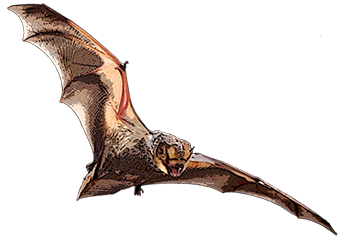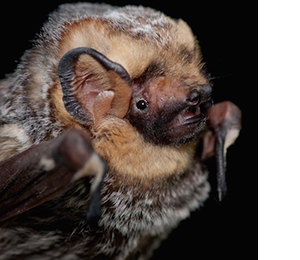Hoary Bat - Species of Concern
 One of North America's most recognizable bats, the Hoary bat is large - up to 17 inch wingspan, a body the size with distinctive coloring - Dark fur tipped with white, a yellowish orange throat, with a dark facial mask and it's round ears edged in black. Their fur is thick and extends over the tail.
One of North America's most recognizable bats, the Hoary bat is large - up to 17 inch wingspan, a body the size with distinctive coloring - Dark fur tipped with white, a yellowish orange throat, with a dark facial mask and it's round ears edged in black. Their fur is thick and extends over the tail.
Hoary bats enjoy the widest range of any North American bat, from Argentina and Chile up to northern Canada. In Oregon, they are found over most of the region west of the Cascades and east of the Cascade range at elevations of 8,000 to 10,000 feet above sea level. Females prefer low elevations whole males are found more often in mountainous areas.

While bird migrations have been studied extensively, but the migration of bats remains a challenge. Miniaturized tracking and sensor devices hold out hope of expanding scientific data on bat migration just as it did with birds previously. Understanding migration and seasonal behaviors is vital to bat conservation efforts.
Threats
- The greatest threat to the Hoary bat (until 2016) is loss of roosting and foraging habitat when diverse forests are replaced by fewer tree species of less diverse ages - as seen in Oregon's clear-cut logging policies where trees are replanted, but entire areas are planted with the same species of tree and at the same time.
- White-nose syndrome is a cold-loving fungus (Pseudogymnoascus destructans) that the U.S. Fish and Wildlife Service estimated had already killed 6.7 million bats just between 2006 and 2012! This fungus attacks bats during hibernation when their body temperatures are low, eating their skin. This causes the bats to wake often during hibernation, using up their fat stores to the point that they die of starvation and physical damage.
A brown bat that probably came from somewhere in the Cascades, died in Washington state on March 13, 2016 of white-nose syndrome. This practically guarantees that Oregon's bats are now facing this devastating killer that had previously been found no further west than Nebraska.
May 2015, a treatment for white-nose syndrome was confirmed, but dispersal of the needed bacteria to combat white-nose is so far problematic.
Learn more about white-nose syndrome treatment development here. - Study finds that more than 600,000 bats may have been killed at wind farms across the U.S. but the study author feels confident that preventing bat deaths at wind farms will be an easy task.
Quick Facts
- Largest and most colorful Oregon bat
- Average weight is about one ounce.
- 16 - 17 inch wingspan
- Dark fur tipped with white, a dark facial mask, a yellow-orange throat, nearly round ears edged in black, with patches of stiff, light tan hairs on its wrists.
- Usually the firsts bat out at night.
- Does not roost in urban areas/buildings, but in trees.
- Highly territorial, these bats emit a high frequency chirp that warns other bats to stay away from their hunting grounds. These warning chirps are audible to humans. They usually return to the same feeding site night after night.
- Usually forage twice - once in early evening and again about an hour before sunrise.
- Relying on their speed and long-distance detection, these bats hunt relatively large insects, prefering moths and beetles.
- Females average 3.9% larger than males.
- Mating is suspected to be accomplished in flight.
- Bat babies are called cubs. The Hoary bat usually gives birth to twins, but can have three or four cubs.
- Their young's eyes open in three days. They hang alone without mom by the seventh day. They learn to fly in around 33 days.
- Assumed to live no more than 6 or 7 years.
 Directly from ODFW - Report Bat Sightings
Directly from ODFW - Report Bat Sightings 
Thursday, April 14, 2016
SALEM, Ore - With the recent confirmation of White-Nose Syndrome (WNS) in a little brown bat in Washington State, ODFW activated an online bat reporting website. Anyone finding a dead bat or who observes bats flying during the day or during freezing weather should report this via the online site or call the ODFW Wildlife Health Hotline at 866-968-2600.
ODFW veterinarian Colin Gillin said WNS is a fungal disease occurring in hibernating bats that has killed more than six million bats since 2006 when it was discovered in New York.
This disease quickly spread to 28 states and five Canadian provinces. Eastern Minnesota and eastern Nebraska were the farthest west that WNS was detected before it made an apparent 1,300 mile geographic leap to Washington.
WNS could potentially transmit to Oregon Conservation Strategy Species, and it could decimate populations of common bat species, putting them in conservation concern.
The USFWS leads a national WNS response effort, working with state and federal partners to survey for the disease.
Cave surveys by ODFW and federal partners over the last two years show no evidence presently of WNS in Oregon’s bat population. ODFW will continue intensive surveillance, education and outreach to help protect this important group of animals in Oregon.
Visit www.whitenosesyndrome.org to follow the latest news, research, and resources.
 Tips from the Oregon Department of Fish & Wildlife
Tips from the Oregon Department of Fish & Wildlife 
- In winter, avoid places where bats hibernate, because awakening a bat depletes energy reserves. A bat can lose 10 to 30 days worth of fat reserves from being awakened and then is at risk of starvation before spring arrives.
- In summer, avoid disturbing nursery caves or roosts. Frightened mother bats may drop or abandon their babies.
- Bats need open water. Support efforts to preserve, create and enhance marshes and wetlands.
- If a bat flies into your house, remove pets and children and close the room and closet doors. Open the windows and quietly watch the bat until it leaves. The bat is most likely lost, young and eager to leave. Watch it to be sure it leaves.
- Never touch or pick up a bat. It may bite in self-defense like any other wild animal. A bat you or your pet can catch outside is probably sick and should be left alone. Do not handle dead bats. Less than 1/10 of 1 percent of all bats are believed to carry rabies. Infected bats are rarely aggressive and soon die of the disease. Nonetheless, always avoid contact with any bat. If you are bitten or scratched by a bat, report it to your doctor and local health authority immediately.
Sources
"7 Things You Probably Didn't Know About Bats | Oregon Wild." Oregonwild.org. n.d. Web. 30 Nov. 2016. <http://www.oregonwild.org/about/blog/7-things-you-probably-didnt-know-about-bats>
N.a. "." Aibs.org. 13 May 2016. Web. 30 Nov. 2016. <https://www.aibs.org/bioscience-press-releases/resources/Hayes.pdf>
ARKive. "Hoary bat photos and facts." ARKive. ARKive, n.d. Web. 30 Nov. 2016. <http://www.arkive.org/hoary-bat/lasiurus-cinereus/>
Animal Diversity Web. "BioKIDS - Kids' Inquiry of Diverse Species, Lasiurus cinereus, hoary bat: INFORMATION." Biokids.umich.edu. n.d. Web. 30 Nov. 2016. <http://www.biokids.umich.edu/critters/Lasiurus_cinereus/>
N.a. "BATS Magazine Article: THE LITTLE-KNOWN WORLD OF HOARY BATS." Batcon.org. n.d. Web. 30 Nov. 2016. <http://www.batcon.org/resources/media-education/bats-magazine/bat_article/719>
N.a. "." Drecp.org. 26 Mar. 2012. Web. 30 Nov. 2016. <http://www.drecp.org/documents/docs/baseline_biology_report/10_Appendix_B_Species_Profiles/10d_Mammal/Hoary%20Bat.pdf>
N.a. "." Dfw.state.or.us. 26 Oct. 2010. Web. 30 Nov. 2016. <http://dfw.state.or.us/wildlife/living_with/docs/BattyForBatsFlyer.pdf>
N.a. "." Dfw.state.or.us. 12 Oct. 2009. Web. 30 Nov. 2016. <http://www.dfw.state.or.us/wildlife/living_with/docs/bats.pdf>
N.a. "Hoary Bat (Lasiurus cinereus)." Tpwd.texas.gov. n.d. Web. 30 Nov. 2016. <http://tpwd.texas.gov/huntwild/wild/species/hoary/>
Itech Post. "Hoary Bat Facts: Scientists Find First Direct Evidence Of Hibernation." iTech Post. 30 Oct. 2016. Web. 30 Nov. 2016. <http://www.itechpost.com/articles/48399/20161030/hoary-bat-facts-scientists-find-first-direct-evidence-hibernation.htm>
N.a. "Killer Fungus That's Devastating Bats May Have Met Its Match." News.nationalgeographic.com. 15 May 2015. Web. 30 Nov. 2016. <http://news.nationalgeographic.com/2015/05/150527-bats-white-nose-syndrome-treatment-conservation-animals-science/>
Mac Crotus. "Bats Northwest." Batsnorthwest.org. 29 Apr. 2007. Web. 30 Nov. 2016. <http://www.batsnorthwest.org/laci_meet.html>N.a. "ODFW, Oregon Wildlife Species: Bats." Dfw.state.or.us. n.d. Web. 30 Nov. 2016. <http://www.dfw.state.or.us/species/mammals/bats.asp>
N.a. "ODFW launches online bat reporting site." Dfw.state.or.us. n.d. Web. 30 Nov. 2016. <http://www.dfw.state.or.us/news/2016/04_april/041516.asp>OregonLive.com. "Northwest bat diagnosed with white-nose syndrome; disease has killed 6 million." OregonLive.com. 31 Mar. 2016. Web. 30 Nov. 2016. <http://www.oregonlive.com/environment/index.ssf/2016/03/northwest_bad_discovered_with.html>
ScienceDaily. "Caught 'napping': First direct evidence of migratory hoary bats hibernating." ScienceDaily. 16 Oct. 2016. Web. 30 Nov. 2016. <https://www.sciencedaily.com/releases/2016/10/161025220312.htm>
Theodore J. Weller. "First Direct Evidence of Long-distance Seasonal Movements and Hibernation in a Migratory Bat." Scientific Reports. 14 Sept. 2016. Web. 30 Nov. 2016. <http://www.nature.com/srep/2016/161004/srep34585/full/srep34585.html>
Verts, B. J., and Leslie N. Carraway. Land mammals of Oregon. Berkeley: University of California Press, 1998. Print.
N.a. "White-nose syndrome: Questions and Answers." Biologicaldiversity.org. 11 Apr. 2016. Web. 30 Nov. 2016.
